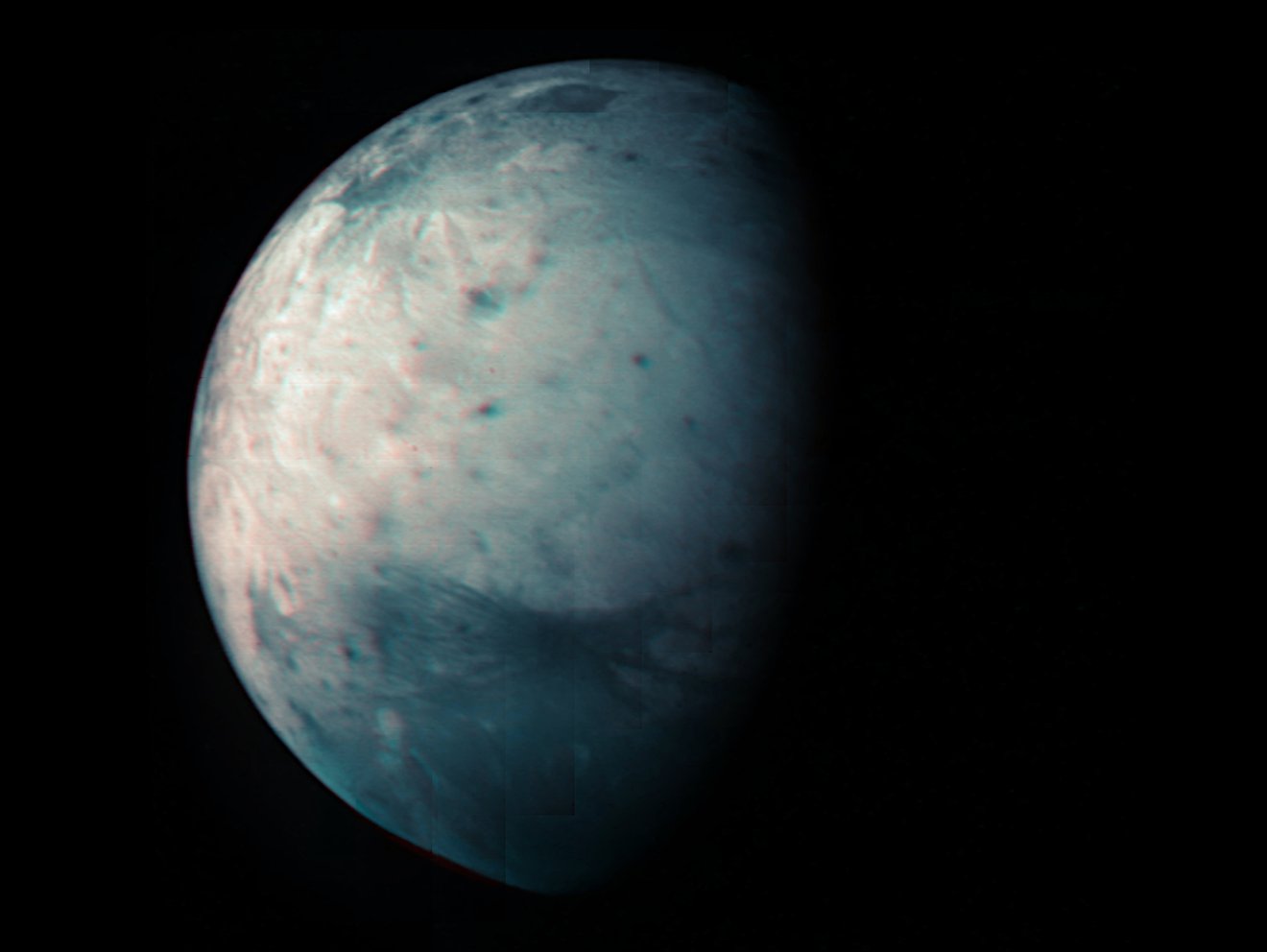On July 20th, 2021, NASA’s Juno spacecraft conducted a flyby of Jupiter’s (and the Solar System’s) largest moon, Ganymede. This close pass was performed as part of the orbiter’s thirty-fourth orbit of the gas giant (Perijove 34), which saw the probe come within 50,109 km (31,136 mi) of the moon’s surface. The mission team took this opportunity to capture images of Ganymede’s using Juno’s Jovian Infrared Auroral Mapper (JIRAM).
These were combined with images acquired during two previous flybys to create a new infrared map of Ganymede’s surface, which was released in honor of the mission’s tenth anniversary (which launched from Earth on Aug. 5th, 2011). This map and the JIRAM instrument could provide new information on Ganymede’s icy shell and the composition of its interior ocean, which could shed led on whether or not it could support life.
The JIRAM instrument was designed to detect infrared light emerging from Jupiter’s interior and characterizing the atmospheric dynamics to a depth of 50 to 70 km (30 to 45 mi) beneath Jupiter’s cloud tops. However, the instrument can also be used to study Jupiter’s largest moons Io, Europa, Ganymede, and Callisto – collectively known as the Galilean moons in honor of their discoverer (Galileo Galilee).
As Scott Bolton, Juno’s Principal Investigator at the Southwest Research Institute (SwRI), explained in a NASA press release:
“Ganymede is larger than the planet Mercury, but just about everything we explore on this mission to Jupiter is on a monumental scale. The infrared and other data collected by Juno during the flyby contain fundamental clues for understanding the evolution of Jupiter’s 79 moons from the time of their formation to today.”
The two previous flybys took place on June 7th, 2021, and Dec. 26th, 2019, when the orbiter came within 50,109 km (31,136 mi) and 1,046 km (650 mi), respectively. The observational geometries these provided allowed the JIRAM instrument to see Ganymede’s northern polar region for the first time, as well as compare the diversity in composition between the low and high latitudes.
In particular, the Juno probe was able to visualize the dramatic effect charged particles (plasma) from Jupiter’s magnetic field have on Ganymede’s surface. Ganymede is unique among the moons of the Solar System because it is the only satellite that has its own magnetic field. On Earth, the presence of a magnetic field causes charged particles from the Sun to enter Earth’s atmosphere around the poles.
These particles then interact with gas molecules in Earth’s upper atmosphere, leading to auroral activity – Aurora Borealis in the northern hemisphere and Aurora Australis in the southern hemisphere. Since Ganymede has no atmosphere to impede the flow of charged particles, the surface around the poles is constantly being bombarded by plasma produced by Jupiter’s giant magnetosphere.

Said Alessandro Mura, a Juno co-investigator from the National Institute for Astrophysics (INAF) in Rome:
“We found Ganymede’s high latitudes dominated by water ice, with fine grain size, which is the result of the intense bombardment of charged particles. Conversely, low latitudes are shielded by the moon’s magnetic field and contain more of its original chemical composition, most notably of non-water-ice constituents such as salts and organics. It is extremely important to characterize the unique properties of these icy regions to better understand the space-weathering processes that the surface undergoes.”
The polar views and close-ups Juno was privy to build on observations made by previous NASA missions that have explored the Jupiter system. These include the Voyager 1 and 2 missions, which passed through the system in 1979 on their way to the outer Solar System; the Cassini-Huygens and New Horizons missions, which flew by in 2000 and 2007 (respectively) on their way to Saturn and Pluto, respectively.
This latest information also builds on observations made by the Galileo spacecraft, which was the first dedicated mission to study Jupiter and its moons (Juno is the second) and the first mission to orbit an outer planet. In the near future, the ESA and NASA will be sending the JUpiter ICy moons Explorer (JUICE) and the Europa Clipper to explore Jupiter’s moons more closely – focusing on Ganymede and Europa, respectively.

The Juno mission lifted off from Cape Canaveral Air Force Station on Aug. 5th, 2011, and traveled 2,800 million km (1,740 million mi) to reach Jupiter on July 4th, 2016. The mission was originally intended to operate for seven years (concluding in 2018) but has since been extended twice: first until July 2021, and more recently until September of 2025. Said Ed Hirst, the Project Manager of the Juno mission at NASA JPL:
“Since launch, Juno has executed over 2 million commands, orbited Jupiter 35 times, and collected about three terabits of science data. We are thrilled by our ongoing exploration of Jupiter, and there is much more to come. We have started our extended mission and look forward to 42 additional orbits to explore the Jovian system.”
The next phase of its extended mission will see Juno tighten its orbit of Jupiter, which will allow it to make several close passes to observe Jupiter’s north polar cyclones. It will also perform additional flybys of Ganymede and make close flybys of Europa and Io (and more of Ganymede). Perhaps most significantly, the orbiter will conduct the first exploration of the faint ring system that encircles the planet, which is where some of Jupiter’s smaller satellites orbit.
These observations will expand on the discoveries Juno has already made about Jupiter’s interior structure, internal magnetic field, atmosphere, and powerful magnetosphere. Encased in a gaseous envelope and governed by such powerful forces, Jupiter is a proverbial onion, its many layers concealing additional scientific discoveries. With its many upcoming orbits, Juno will continue to peel back layers to learn more about how Jupiter and other gas giants formed and evolved.
Further Reading: NASA

